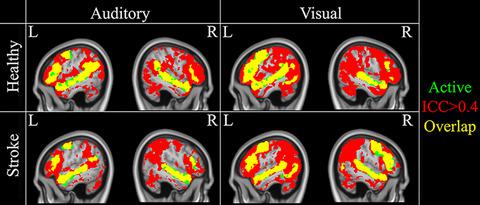当前位置:
X-MOL 学术
›
Eur. J. Nerosci.
›
论文详情
Our official English website, www.x-mol.net, welcomes your feedback! (Note: you will need to create a separate account there.)
Reliability of BOLD signals in chronic stroke-induced aphasia.
European Journal of Neroscience ( IF 3.4 ) Pub Date : 2020-04-13 , DOI: 10.1111/ejn.14739 James Higgins 1, 2 , Elena Barbieri 1, 3 , Xue Wang 1, 2 , Jennifer Mack 1, 3 , David Caplan 1, 4 , Swathi Kiran 1, 5 , Brenda Rapp 1, 6 , Cynthia Thompson 1, 3, 7 , Richard Zinbarg 1, 8, 9 , Todd Parrish 1, 2
European Journal of Neroscience ( IF 3.4 ) Pub Date : 2020-04-13 , DOI: 10.1111/ejn.14739 James Higgins 1, 2 , Elena Barbieri 1, 3 , Xue Wang 1, 2 , Jennifer Mack 1, 3 , David Caplan 1, 4 , Swathi Kiran 1, 5 , Brenda Rapp 1, 6 , Cynthia Thompson 1, 3, 7 , Richard Zinbarg 1, 8, 9 , Todd Parrish 1, 2
Affiliation

|
Investigating the neurobiology of language impairment and treatment in chronic stroke aphasia using fMRI requires an understanding of measurement variability within and between participants. In this multicenter study, we evaluated the scan–rescan reliability of an auditory and visual (written) story comprehension paradigm in stroke participants with aphasia (N = 65) and healthy controls (N = 22). The multi‐modal task was conducted twice (~1 week apart) on separate visits upon study enrolment and twice again at completion three months later. A non‐language visuomotor task was studied in the aphasia group only, which was conducted once per time point (3 months apart). While participants were asked to make responses during the comprehension task, these in‐scanner responses were not recorded. Reliability was assessed using intraclass correlation coefficient (ICC) at both group and individual participant levels. The visual story comprehension condition had higher reliability than the auditory condition in both groups, with participants with aphasia exhibiting lower reliability than controls in both conditions (stroke ICC = .43, healthy ICC = .81). Differences in reliability within the group of participants with aphasia were found to be partially explained by overall language impairment as well as greater head motion. In the participants with aphasia, the visuomotor paradigm was found to have greater reliability than the story comprehension task at equivalent interscan intervals (visuomotor = 0.50, comprehension = 0.34), and its reliability was not associated with language impairment. This work highlights the importance of considering the reliability of fMRI tasks in aphasia research, provides strategies to improve reliability and has potential implications for the field of clinical neuroimaging in general.
中文翻译:

慢性卒中性失语症中BOLD信号的可靠性。
使用功能磁共振成像研究慢性卒中性失语的语言障碍和治疗的神经生物学需要了解参与者内部和参与者之间的测量变异性。在这项多中心研究中,我们评估了失语症(N = 65)和健康对照(N的中风参与者的听觉和视觉(书面)故事理解范式的扫描-再扫描可靠性。 = 22)。在参加研究时,多模式任务在单独的访问中进行了两次(相距约1周),三个月后在完成时再次进行了两次。仅在失语症患者中研究了非语言视觉运动任务,该任务在每个时间点进行一次(间隔3个月)。尽管要求参与者在理解任务期间做出回应,但并未记录这些扫描仪内回应。使用组内相关系数(ICC)在组和个体参与者水平上评估可靠性。两组的视觉故事理解条件比听觉条件具有更高的信度,两种情况下失语症参与者的信度都比对照组低(中风ICC = .43,健康ICC = .81)。发现失语症参与者组中的可靠性差异部分由整体语言障碍以及更大的头部运动引起。在失语症参与者中,在同等扫描间隔内(视觉运动= 0.50,理解= 0.34),视觉运动范例比故事理解任务具有更高的可靠性,并且其可靠性与语言障碍无关。这项工作凸显了在失语症研究中考虑fMRI任务可靠性的重要性,提供了提高可靠性的策略,并且对临床神经影像学领域具有一般意义。发现在同等的扫描间隔内,视觉运动范例比故事理解任务具有更高的可靠性(视觉运动= 0.50,理解= 0.34),并且其可靠性与语言障碍无关。这项工作凸显了在失语症研究中考虑fMRI任务可靠性的重要性,提供了提高可靠性的策略,并且对临床神经影像学领域具有一般意义。发现在同等的扫描间隔内,视觉运动范例比故事理解任务具有更高的可靠性(视觉运动= 0.50,理解= 0.34),并且其可靠性与语言障碍无关。这项工作凸显了在失语症研究中考虑fMRI任务可靠性的重要性,提供了提高可靠性的策略,并且对临床神经影像学领域具有一般意义。
更新日期:2020-04-13
中文翻译:

慢性卒中性失语症中BOLD信号的可靠性。
使用功能磁共振成像研究慢性卒中性失语的语言障碍和治疗的神经生物学需要了解参与者内部和参与者之间的测量变异性。在这项多中心研究中,我们评估了失语症(N = 65)和健康对照(N的中风参与者的听觉和视觉(书面)故事理解范式的扫描-再扫描可靠性。 = 22)。在参加研究时,多模式任务在单独的访问中进行了两次(相距约1周),三个月后在完成时再次进行了两次。仅在失语症患者中研究了非语言视觉运动任务,该任务在每个时间点进行一次(间隔3个月)。尽管要求参与者在理解任务期间做出回应,但并未记录这些扫描仪内回应。使用组内相关系数(ICC)在组和个体参与者水平上评估可靠性。两组的视觉故事理解条件比听觉条件具有更高的信度,两种情况下失语症参与者的信度都比对照组低(中风ICC = .43,健康ICC = .81)。发现失语症参与者组中的可靠性差异部分由整体语言障碍以及更大的头部运动引起。在失语症参与者中,在同等扫描间隔内(视觉运动= 0.50,理解= 0.34),视觉运动范例比故事理解任务具有更高的可靠性,并且其可靠性与语言障碍无关。这项工作凸显了在失语症研究中考虑fMRI任务可靠性的重要性,提供了提高可靠性的策略,并且对临床神经影像学领域具有一般意义。发现在同等的扫描间隔内,视觉运动范例比故事理解任务具有更高的可靠性(视觉运动= 0.50,理解= 0.34),并且其可靠性与语言障碍无关。这项工作凸显了在失语症研究中考虑fMRI任务可靠性的重要性,提供了提高可靠性的策略,并且对临床神经影像学领域具有一般意义。发现在同等的扫描间隔内,视觉运动范例比故事理解任务具有更高的可靠性(视觉运动= 0.50,理解= 0.34),并且其可靠性与语言障碍无关。这项工作凸显了在失语症研究中考虑fMRI任务可靠性的重要性,提供了提高可靠性的策略,并且对临床神经影像学领域具有一般意义。



























 京公网安备 11010802027423号
京公网安备 11010802027423号